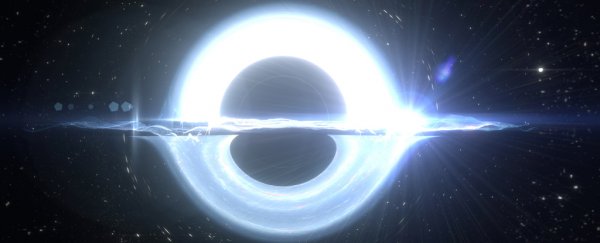A fifty-year-old hypothesis predicting the existence of bodies dubbed Generic Objects of Dark Energy (GEODEs) is getting a second look in light of a proposed correction to assumptions we use to model the way our Universe expands.
If this new version of a classic cosmological model is correct, some black holes could hide cores of pure dark energy, pushing our Universe apart at the seams.
University of Hawai'i astrophysicist Kevin Croker and mathematician Joel Weiner teamed up to challenge the broadly accepted notion that when it comes to the Universe's growing waistline, its contents are largely irrelevant.
"For 80 years, we've generally operated under the assumption that the Universe, in broad strokes, was not affected by the particular details of any small region," said Croker.
"It is now clear that general relativity can observably connect collapsed stars – regions the size of Honolulu – to the behaviour of the Universe as a whole, over a thousand billion billion times larger."
Not only could this alternative interpretation of fundamental physics change how we understand the Universe's expansion, but we might need to also consider how that growth might affect compact objects like the cores of collapsing stars.
The fact that space has been steadily adding real estate for the past 13.8 billion years is by now a widely accepted feature of our Universe.
The set of equations we use to describe this expansion was first put to paper just under a century ago by the Russian physicist Alexander Friedmann. They provided a solution to Einstein's theory of general relativity that now underpins our big picture model of cosmology.
As useful as Friedmann's equations have been, they're based on the assumption that any matter floating around inside this expanding space is more or less made of the same kind of stuff, and spread out fairly evenly.
This means we tend to ignore the swirls of stars and galaxies – just like we might not include ducks in the hydrodynamics of a lake.
But Croker and Weiner wonder what might happen to space and the objects it contains if we made some reasonable changes to the assumptions that inform these equations.
The consequences aren't trivial.
According to their adjusted model, the averaged contributions of our metaphorical ducks might affect the lake's water after all.
What's more, the lake's expansion would also affect how the ducks swim, causing them to lose or gain energy depending on their species.
Theoretically, this interpretation would mean we need to take the Universe's growth into account when describing certain phenomena, such as the death of a star.
In 1966, a Russian physicist named Erast Gliner considered how some densities of space close to the Big Bang might look – in terms of relativity – like a vacuum that could counter the effects of gravity.
His solution would look like a black hole from the outside. But inside would be a bubble of energy shoving against the surrounding Universe.
Half a century later, astrophysicists are on the hunt for just such a pushing power that might be responsible for the Universe's expansion picking up speed over time.
Today we refer to this undescribed force as dark energy, but could Gliner's pockets of relativistic nothingness be the source of our Universe's accelerating expansion?
Based on Croker and Weiner's work, if just a few ancient stars were to have collapsed into Gliner's GEODEs instead of the more typical puckered space of a singularity, their average effect on expanding space would look just like dark energy.
The pair go further, applying their corrected model to the first observation of gravitational waves from a black hole collision as measured by LIGO.
To make the math fit, it's assumed the stars that formed the merging black holes formed in a low-metallicity environment, which makes them somewhat rare.
Technically, the energy of a GEODE should evolve as the Universe grows, effectively compacting as a cosmological equivalent of a 'blueshift'.
If the merging black holes were GEODEs, according to the researchers, there'd be no need to assume the black holes were born in an unusual patch of space.
"What we have shown is that if GEODEs do exist, then they can easily give rise to observed phenomena that presently lack convincing explanations," the researchers said.
"We anticipate numerous other observational consequences of a GEODE scenario, including many ways to exclude it. We've barely begun to scratch the surface."
Testing assumptions like these is a vital part of physics. We're a long way off including GEODEs in any official astrophysical zoo of weird objects, but it's possible these could be the dark hearts of the Universe we've been looking for.
This research was published in The Astrophysical Journal.
